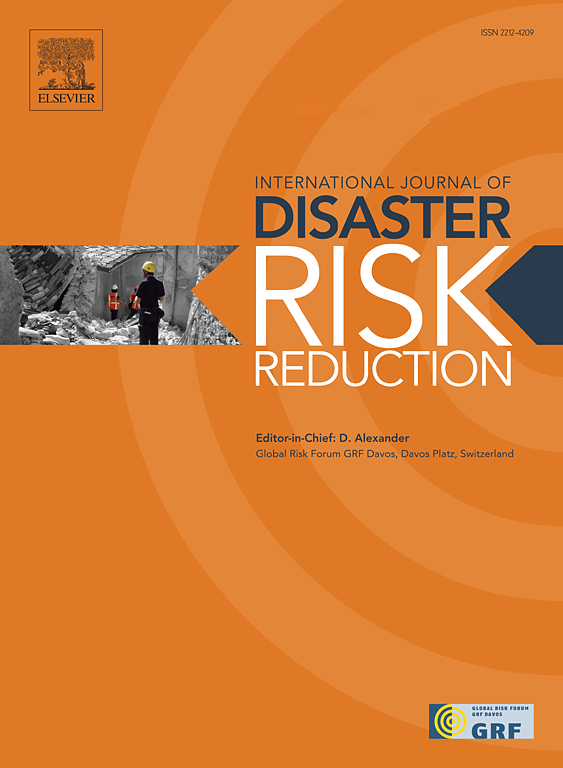基于属性依赖驱动的森林火灾危险因素识别方法及其耦合关系
IF 4.2
1区 地球科学
Q1 GEOSCIENCES, MULTIDISCIPLINARY
International journal of disaster risk reduction
Pub Date : 2025-05-12
DOI:10.1016/j.ijdrr.2025.105529
引用次数: 0
摘要
识别森林火灾危险因素及其耦合关系对于揭示火灾发生机制和评估火灾风险具有重要意义。然而,以往对森林火灾危险因素的研究往往忽略了危险因素之间的差异和耦合效应,导致风险预测不准确。鉴于此,本研究将模糊粗糙集的属性依赖引入森林火灾,构建了一种识别关键危险因素及其耦合效应测度的新方法。以加拿大汤普森地区1984 - 2023年的森林火灾风险为研究对象,通过属性依赖函数量化各风险因素对森林火灾的影响。然后,根据各风险因素的影响程度进行加权处理,结合模糊互信息的重叠思想度量风险因素的耦合效应。结果表明,气候因子对森林火灾的影响显著,地形因子、植被因子和人为因素对森林火灾的影响相对较弱。地形因素、植被因素和人为因素的耦合效应也较弱,但气候因素与地形因素、植被因素和人为因素的组合显著增强了其影响。本文章由计算机程序翻译,如有差异,请以英文原文为准。
Identification method of forest fire risk factors and their coupling relationship driven by attribute dependence
Identifying forest fire risk factors and their coupling relationships is crucial for revealing the mechanism of fire occurrence and assessing risks. However, previous studies on forest fire risk factors often ignore the differences and coupling effects between risk factors, resulting in inaccurate risk prediction. Given this, this study introduces the attribute dependence of fuzzy rough set into forest fires and constructs a new method to identify key risk factors and measure their coupling effects. Taking the forest fire risk in the Thompson area of Canada from 1984 to 2023 as the research object, the influence of each risk factor on forest fire is quantified by the attribute dependence function. Then, according to the influence degree of each risk factor, the weighted processing is carried out, and the coupling effect of risk factors is measured by combining the overlapping idea of fuzzy mutual information. The results show that climate factors have a significant impact on forest fires, while topographic factors, vegetation factors, and human factors are relatively weak. The coupling effect of topographic factors, vegetation factors, and human factors is also weak, but the combination of climate factors and topographic factors, vegetation factors, and human factors significantly enhances its influence.
求助全文
通过发布文献求助,成功后即可免费获取论文全文。
去求助
来源期刊

International journal of disaster risk reduction
GEOSCIENCES, MULTIDISCIPLINARYMETEOROLOGY-METEOROLOGY & ATMOSPHERIC SCIENCES
CiteScore
8.70
自引率
18.00%
发文量
688
审稿时长
79 days
期刊介绍:
The International Journal of Disaster Risk Reduction (IJDRR) is the journal for researchers, policymakers and practitioners across diverse disciplines: earth sciences and their implications; environmental sciences; engineering; urban studies; geography; and the social sciences. IJDRR publishes fundamental and applied research, critical reviews, policy papers and case studies with a particular focus on multi-disciplinary research that aims to reduce the impact of natural, technological, social and intentional disasters. IJDRR stimulates exchange of ideas and knowledge transfer on disaster research, mitigation, adaptation, prevention and risk reduction at all geographical scales: local, national and international.
Key topics:-
-multifaceted disaster and cascading disasters
-the development of disaster risk reduction strategies and techniques
-discussion and development of effective warning and educational systems for risk management at all levels
-disasters associated with climate change
-vulnerability analysis and vulnerability trends
-emerging risks
-resilience against disasters.
The journal particularly encourages papers that approach risk from a multi-disciplinary perspective.
 求助内容:
求助内容: 应助结果提醒方式:
应助结果提醒方式:


